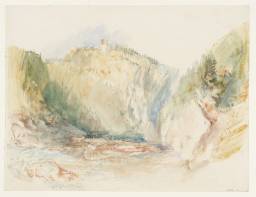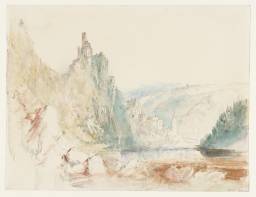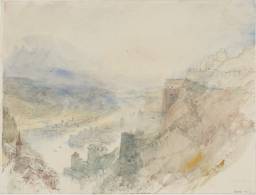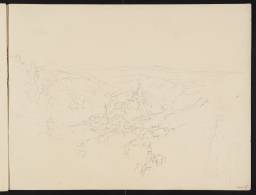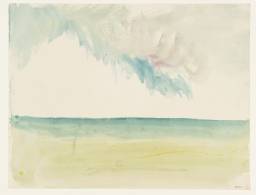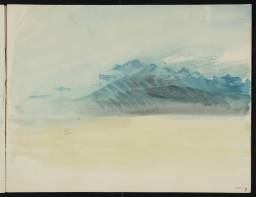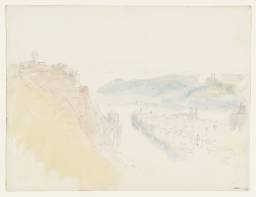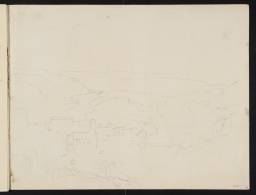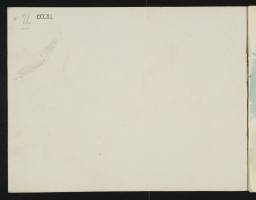Turner Bequest CCCXL 1–10
9 leaves from a disbound ‘roll’ sketchbook, originally bound in covers of plain buff card, laminated over white wove endpapers (D40436, D33675)
Endpapers and separated leaves of white wove paper, page size approximately 212 x 276 mm
Maker perhaps Richard Turner, Upper Tolvil Mill, Maidstone, Kent; numerous leaves watermarked ‘R Turner’
Stamped in black ‘CCCXL’ top right of front cover
Endpapers and separated leaves of white wove paper, page size approximately 212 x 276 mm
Maker perhaps Richard Turner, Upper Tolvil Mill, Maidstone, Kent; numerous leaves watermarked ‘R Turner’
Stamped in black ‘CCCXL’ top right of front cover
Accepted by the nation as part of the Turner Bequest 1856
References
This sketchbook, with its few pages all now neatly separated (see the technical notes below), largely comprises views around the southern German city of Passau, with its cathedral and church spires picturesquely clustered on a peninsula at the confluence of the Rivers Danube and Inn overlooked by the Oberhaus fortress, and of the castle ruins of Burg Hals above the meandering River Ilz, in wooded countryside barely a mile due north of Passau.1 There are also three swift but typically evocative colour studies of clouds seen over the sea from a beach.
As Cecilia Powell has noted, this is one of only two British ‘roll’ sketchbooks that Turner is known to have used on his 1840 tour. The other, now called the Grand Canal and Giudecca book (Tate; Turner Bequest CCCXV), was used or begun exclusively in Venice,2 its disbound watercolour studies bearing ‘marked similarities of style, colour and technique’3 to those grouped here. There was likely a third, notionally known as the ‘Storm’ sketchbook, again used for Venetian subjects as discussed in the Introduction to Grand Canal and Giudecca. The present sketchbook’s leaves are noticeably smaller.
Following John Ruskin’s initial tentative identification of Grenoble among its subjects (perhaps thinking of the rivers as the Drac and the Isère), Finberg had called this the ‘Grenoble (?)’ sketchbook, and dated it the about 1841.4 It was not until 1974 that one of the views of Passau (D33668; CCCXL 3) was firmly identified by Andrew Wilton, who dated it to about 1840 and observed: ‘It is clear ... that the town represented is that which appears in the ‘Coburg, Bamberg and Venice’ sketchbook ([now Venice; Passau to Würzburg: Tate D31384, D31386] T.B.CCCX, ff.55, 56). Many drawings in both CCCXL and CCCX can be identified as showing sites on the Danube near Ratisbon [Regensburg], including the ‘Walhalla’, completed in 1840.’5 Nevertheless, Martin Butlin and Evelyn Joll continued to associate the contents with Grenoble, albeit only in passing.6 Turner had first visited the city at the foot of the French Alps in 1802 (see the 1802 Grenoble sketchbook, particularly Tate D04506–D04507; Turner Bequest LXXIV 14, 14a) and used the Genoa to Grenoble sketchbook (Tate; Turner Bequest CCXCV) in 1837; see also David Blayney Brown’s section on ‘Grenoble Bridge c.1824’ in the present catalogue. Turner’s extensive 1840 itinerary did not involve France.
In relation to her 1995 Turner and Germany exhibition, Cecilia Powell renamed this book ‘Passau and Burg Hals’, provided a checklist fully identifying the topographical sketches,7 and discussed the main subjects in detail.8 On his long homeward itinerary after leaving Venice on 3 September, Turner reached Passau by steamer westwards up the Austrian Danube from Vienna, where his presence had been noted on the 7th, making notes indicating he was still approaching Passau three days later. He would be in Regensburg, further upstream into Germany, by 14 September if not a day or two before; see the Introductions to the preceding Trieste, Graz and Danube and subsequent Venice; Passau to Würzburg sketchbooks (Tate; Turner Bequest CCXCIX, CCCX). He made pencil sketches at Passau in the first (see Tate D30058; Turner Bequest CCXCIX 31), and around the city and Hals in the second (see respectively under D31371 and D31391; CCCX 48a, 58a).
Passau is shown on D33668 and D33674–D33675 (CCCXL 3, 9–10), Burg Hals on D33667, D33669 and D33670 (CCCXL 2, 4, 5), and nearby Burg Reschenstein on D33666 (CCCXL 1). Of these, D33666–D33668 and D33674 were developed in watercolour over pencil outlines, with the others left untinted. As discussed in the parallel subsection of separate sheets used on this return journey, there are also three pencil, watercolour and gouache studies of the city on grey paper (Tate D28993, D29006, D33871; Turner Bequest CCXCII 46, 57, CCCXLI 174);9 Burg Hals was also the subject of several atmospheric colour studies on both brown and grey papers (Tate D24776, D28960, D28997, D29011–D29012, D36162; Turner Bequest CCLIX 211, CCXCII 13, 49, 60, 61, CCCLXIV 305).10 All of this intensive work led to one finished light-filled watercolour on conventional white paper, Passau, Germany, at the Confluence of the Rivers Inn and Danube (National Gallery of Ireland, Dublin).11
The three variant studies of clouds over a beach, in watercolour alone (D33671–D33673; CCCXL 6–8), were perhaps observations or recollections of Ostend on the Belgian North Sea coast,12 where Turner seems to have had some time in hand to explore the shoreline before embarked for his return crossing to England (see under Tate D30460; Turner Bequest CCCIII 1, in the Würzburg, Rhine and Ostend book).
The covers do not bear the usual Turner Bequest blind stamp; nor is there a brief descriptive endorsement and schedule number of the kind usually inscribed in the sketchbooks and signed by the Executors. Finberg’s 1909 Inventory recorded John Ruskin’s separate note (since lost): ‘12. Book, unfinished, of 7 coloured and 3 pencil sketches; 3 of the coloured mere effects, four subjects from (Grenoble ?), and another fortress. One of the pencil sketches is a continuation of a coloured one on another leaf.’13 This tallies with the pages later listed by Finberg and associated with the book today.
Technical notes
How to cite
Matthew Imms, ‘Passau and Burg Hals Sketchbook 1840’, sketchbook, September 2018, in David Blayney Brown (ed.), J.M.W. Turner: Sketchbooks, Drawings and Watercolours, Tate Research Publication, December 2019, https://www

